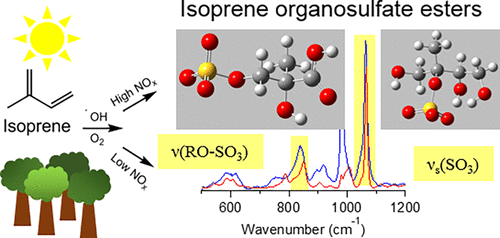当前位置:
X-MOL 学术
›
J. Phys. Chem. A
›
论文详情
Our official English website, www.x-mol.net, welcomes your
feedback! (Note: you will need to create a separate account there.)
Isoprene-Derived Organosulfates: Vibrational Mode Analysis by Raman Spectroscopy, Acidity-Dependent Spectral Modes, and Observation in Individual Atmospheric Particles
The Journal of Physical Chemistry A ( IF 2.7 ) Pub Date : 2017-12-27 00:00:00 , DOI: 10.1021/acs.jpca.7b10587 Amy L. Bondy 1 , Rebecca L. Craig 1 , Zhenfa Zhang 2 , Avram Gold 2 , Jason D. Surratt 2 , Andrew P. Ault 1, 3
The Journal of Physical Chemistry A ( IF 2.7 ) Pub Date : 2017-12-27 00:00:00 , DOI: 10.1021/acs.jpca.7b10587 Amy L. Bondy 1 , Rebecca L. Craig 1 , Zhenfa Zhang 2 , Avram Gold 2 , Jason D. Surratt 2 , Andrew P. Ault 1, 3
Affiliation

|
Isoprene, the most abundant biogenic volatile organic compound (BVOC) in the atmosphere, and its low-volatility oxidation products lead to secondary organic aerosol (SOA) formation. Isoprene-derived organosulfates formed from reactions of isoprene oxidation products with sulfate in the particle phase are a significant component of SOA and can hydrolyze forming polyols. Despite characterization by mass spectrometry, their basic structural and spectroscopic properties remain poorly understood. Herein, Raman microspectroscopy and density functional theory (DFT) calculations (CAM-B3LYP level of theory) were combined to analyze the vibrational modes of key organosulfates, 3-methyltetrol sulfate esters (racemic mixture of two isomers), and racemic 2-methylglyceric acid sulfate ester, and hydrolysis products, 2-methyltetrols, and 2-methylglyceric acid. Two intense vibrational modes were identified, ν(RO–SO3) (846 ± 4 cm–1) and νs(SO3) (1065 ± 2 cm–1), along with a lower intensity δ(SO3) mode (586 ± 2 cm–1). For 2-methylglyceric acid and its sulfate esters, deprotonation of the carboxylic acid at pH values above the pKa decreased the carbonyl stretch frequency (1724 cm–1), while carboxylate modes grew in for νs(COO–) and νa(COO–) at 1413 and 1594 cm–1, respectively. The ν(RO–SO3) and νs(SO3) modes were observed in individual atmospheric particles and can be used in future studies of complex SOA mixtures to distinguish organosulfates from inorganic sulfate or hydrolysis products.
中文翻译:

异戊二烯衍生的有机硫酸盐:通过拉曼光谱,酸度相关的光谱模式进行的振动模式分析以及在单个大气颗粒中的观察
异戊二烯是大气中生物含量最高的生物挥发性有机化合物(BVOC),其低挥发性氧化产物可导致二次有机气溶胶(SOA)的形成。由异戊二烯氧化产物与颗粒相中的硫酸盐反应形成的异戊二烯衍生的有机硫酸盐是SOA的重要组成部分,可水解形成多元醇。尽管通过质谱表征,但对其基本结构和光谱性质仍知之甚少。在这里,拉曼光谱和密度泛函理论(DFT)计算(理论的CAM-B3LYP水平)相结合,分析了关键有机硫酸盐,3-甲基四硫代硫酸酯(两种异构体的外消旋混合物)和外消旋2-甲基甘油酸的振动模式。硫酸酯,水解产物,2-甲基四醇和2-甲基甘油酸。3)(846±4厘米-1)和ν小号(SO 3)(1065±2厘米-1),具有较低强度δ沿(SO 3)模式(586±2厘米-1)。对于2 methylglyceric酸及其硫酸酯,羧酸在高于所述p的pH值的去质子化ķ一个降低了羰基伸缩频率(1724厘米-1),而羧酸模式长大为ν小号(COO - )和ν一个(COO –)分别位于1413和1594 cm –1处。在ν(RO-SO 3)和ν小号(SO 3模式是在单个大气颗粒中观察到的,可用于将来复杂SOA混合物的研究中,以区分有机硫酸盐与无机硫酸盐或水解产物。
更新日期:2017-12-27
中文翻译:

异戊二烯衍生的有机硫酸盐:通过拉曼光谱,酸度相关的光谱模式进行的振动模式分析以及在单个大气颗粒中的观察
异戊二烯是大气中生物含量最高的生物挥发性有机化合物(BVOC),其低挥发性氧化产物可导致二次有机气溶胶(SOA)的形成。由异戊二烯氧化产物与颗粒相中的硫酸盐反应形成的异戊二烯衍生的有机硫酸盐是SOA的重要组成部分,可水解形成多元醇。尽管通过质谱表征,但对其基本结构和光谱性质仍知之甚少。在这里,拉曼光谱和密度泛函理论(DFT)计算(理论的CAM-B3LYP水平)相结合,分析了关键有机硫酸盐,3-甲基四硫代硫酸酯(两种异构体的外消旋混合物)和外消旋2-甲基甘油酸的振动模式。硫酸酯,水解产物,2-甲基四醇和2-甲基甘油酸。3)(846±4厘米-1)和ν小号(SO 3)(1065±2厘米-1),具有较低强度δ沿(SO 3)模式(586±2厘米-1)。对于2 methylglyceric酸及其硫酸酯,羧酸在高于所述p的pH值的去质子化ķ一个降低了羰基伸缩频率(1724厘米-1),而羧酸模式长大为ν小号(COO - )和ν一个(COO –)分别位于1413和1594 cm –1处。在ν(RO-SO 3)和ν小号(SO 3模式是在单个大气颗粒中观察到的,可用于将来复杂SOA混合物的研究中,以区分有机硫酸盐与无机硫酸盐或水解产物。











































 京公网安备 11010802027423号
京公网安备 11010802027423号